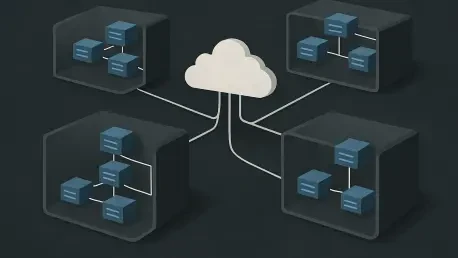The Cloud Revolution Reshaping Business Foundations
What happens when the core of a business’s digital strategy evolves beyond traditional server rooms into a seamless blend of technologies that redefine data management? Hybrid cloud has emerged as a transformative force in 2025, altering the landscape of IT infrastructure at a rapid pace. This powerful combination of public and private cloud environments is not just a trend but a fundamental shift, with data centers playing a central role in enabling this change. The impact is profound, touching every aspect of how companies operate in a data-driven world.
The stakes are high as businesses race to adapt to escalating demands for speed, security, and scalability. With global spending on cloud services projected to grow by 20% annually from 2025 to 2027 according to industry forecasts, the urgency to understand this evolution cannot be overstated. Data centers, once seen as mere storage hubs, are now critical to unlocking the full potential of hybrid cloud solutions, sparking curiosity about how these shifts redefine operational roles.
Why Hybrid Cloud Dominates Tech Conversations
Hybrid cloud has captured the attention of the tech world by offering a balanced approach to the complex needs of modern enterprises. By integrating the flexibility of public cloud platforms with the control of private environments, this model addresses pressing challenges like regulatory compliance and fluctuating workloads. It’s no surprise that a recent survey by a leading IT research firm found that over 80% of organizations have adopted some form of hybrid architecture in 2025, signaling its dominance in strategic planning.
Data centers stand at the forefront of this paradigm shift, evolving to meet the unique demands of hybrid setups. Their ability to provide tailored infrastructure solutions makes them indispensable partners for companies navigating the intricacies of multi-cloud environments. This synergy has turned hybrid cloud into a cornerstone of IT discussions, highlighting the need to explore how data center roles are being redefined to support such dynamic systems.
The Strategic Shift in Data Center Functions
Data centers have transitioned from static facilities housing servers to dynamic enablers of hybrid cloud success. No longer just physical spaces, they now offer specialized services like colocation, which allows businesses to place private infrastructure in shared facilities without the burden of building their own. This shift democratizes access to hybrid cloud for smaller enterprises, reducing capital costs while maintaining robust control over sensitive data.
Another critical evolution is the rise of edge facilities, designed to minimize latency by positioning workloads closer to end users. For industries reliant on real-time data—think streaming platforms or IoT applications—this capability is a game-changer, enhancing hybrid cloud performance significantly. Additionally, interconnection solutions ensure smooth data flow between public and private clouds, tackling integration hurdles that often plague hybrid setups.
A striking example comes from a mid-sized e-commerce company that leveraged edge data centers to slash page load times by 40%, boosting customer satisfaction. Supported by statistics showing hybrid cloud adoption rising by 15% annually since 2025, it’s clear that data centers are no longer just support systems but strategic assets driving business outcomes in hybrid architectures.
Expert Perspectives on Cloud and Data Center Synergy
Insights from industry leaders provide a deeper understanding of how hybrid cloud is reshaping data center responsibilities. A prominent IT analyst recently noted, “Data centers have moved from being mere hosts to active partners in hybrid cloud strategies, offering solutions that bridge critical gaps.” This perspective underscores a fundamental change in perception, where data centers are seen as integral to achieving seamless cloud integration.
Beyond expert opinions, real-world experiences add a relatable dimension to this transformation. A technology manager from a financial services firm shared how adopting colocation services within a data center eased their transition to a hybrid model, cutting infrastructure costs by nearly 30%. Such anecdotes, paired with research indicating that 70% of hybrid cloud users rely on data center services for scalability, highlight the tangible benefits of this evolving relationship.
These voices collectively emphasize a unified trend: data centers are adapting to become more than infrastructure providers. They are now essential collaborators, offering expertise and resources that empower businesses to maximize the value of hybrid cloud investments while addressing operational complexities.
Actionable Steps for Harnessing Hybrid Cloud Potential
For organizations aiming to capitalize on these advancements, a clear roadmap can make all the difference in integrating hybrid cloud with modern data center innovations. Start by assessing workload requirements to determine which applications need the scalability of public cloud versus the security of private environments. Data center Infrastructure-as-a-Service (IaaS) offerings can provide a balanced solution, blending control with convenience for optimal results.
Prioritizing edge computing is another vital step, especially for latency-sensitive operations. Partnering with data centers that offer edge facilities can significantly enhance performance for applications like real-time analytics. Similarly, leveraging colocation services helps avoid hefty capital expenses by utilizing shared spaces for private infrastructure, a cost-effective approach for hybrid setups of any scale.
Ensuring seamless connectivity remains crucial to eliminate bottlenecks between cloud environments. Collaborating with data centers that provide robust interconnection solutions can streamline data movement, enhancing overall efficiency. These practical strategies, adaptable to diverse business needs, offer a pathway to navigate the hybrid cloud landscape with confidence and precision.
Reflecting on a Transformed Landscape
Looking back, the journey of hybrid cloud and data centers reveals a remarkable evolution in how businesses approach digital infrastructure. What began as a niche concept grew into a strategic imperative, with data centers adapting to become indispensable allies in this shift. Their expanded roles—from providing colocation to enabling edge computing—proved critical in meeting the diverse demands of hybrid architectures.
As companies reflect on these changes, the next steps become clear: embracing continuous innovation is essential to stay competitive. Exploring partnerships with data centers for emerging services like advanced IaaS or next-gen interconnection could unlock further efficiencies. The path forward demands a proactive mindset, focusing on integrating cutting-edge solutions to address evolving challenges in a data-centric world.









